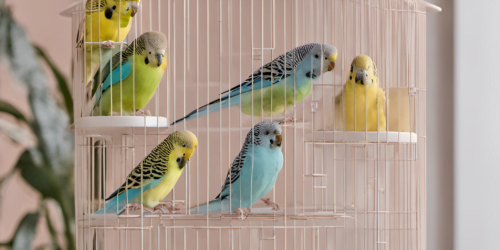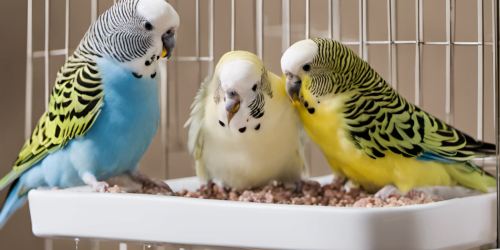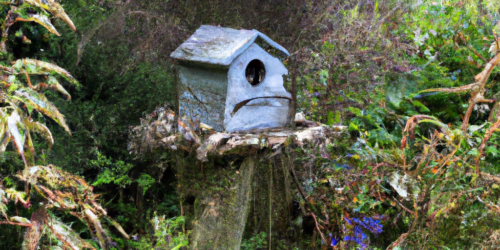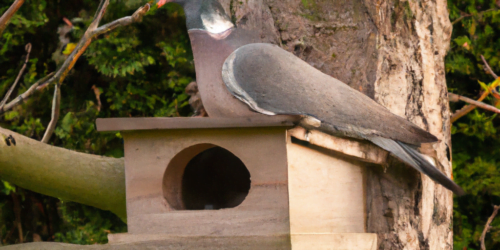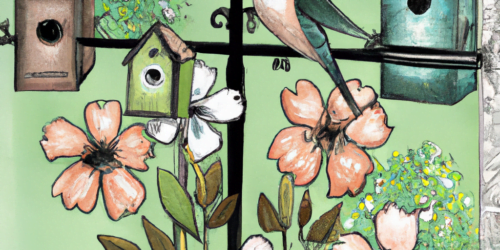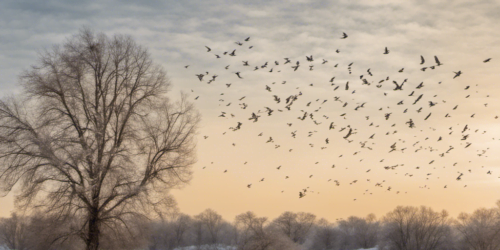How To Spot The Robin Bird in 2023

The American robin bird, often simply referred to as a robin, is a familiar bird to many people. With its vibrant orange breast and melodic songs, this bird is a true symbol of spring.
In this article, we will explore everything you need to know about robins, from their nesting habits to their migratory patterns.
So, let’s dive into the world of the robin bird!
Appearance and Identification
Table Of Contents
The robin bird, measuring around 9-11 inches long, is easily recognizable by its bright orange-red breast, brownish back, and white belly.
Adult robins also have a distinctive black head with a white eye ring, which makes their eyes stand out. However, it’s worth noting that juvenile robins have a speckled appearance until they mature.
Nesting and Eggs
Robin birds build their nests in a variety of locations, including trees, shrubs, and even on buildings.
These nests are cup-shaped and constructed with a mixture of mud, small twigs, grass, and lined with soft materials like moss and feathers.
The female robin is responsible for most of the nest building, while the male assists by bringing materials.
Once the nest is completed, the female will lay blue-green eggs with brownish speckles. An average clutch consists of three to five eggs, and the female incubates them for about 12-14 days. Interestingly, robins can have multiple broods in a single breeding season.
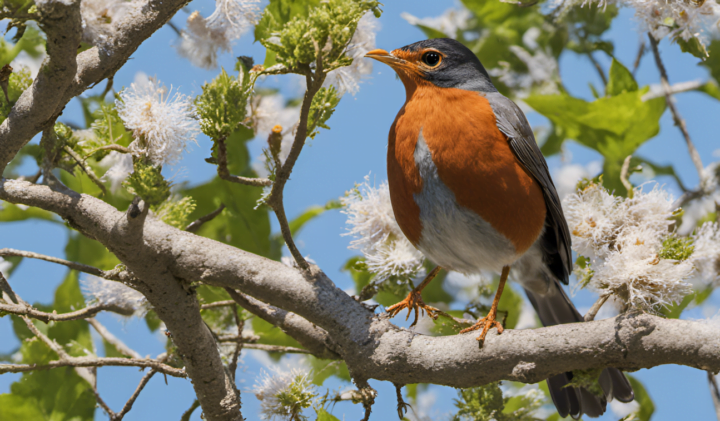
Migration Patterns
Robins are known for their impressive migratory journeys. During summer, they can be found in the United States and Canada, but as winter approaches, many robins fly south to warmer areas.
Some robins may stay in their breeding range through winter if food sources are available.
While robins are migratory birds, they don’t all migrate at the same time. Instead, they migrate in waves, with younger birds leaving later than their older counterparts.
This staggered migration can last for several weeks and often coincides with the abundance of fruits in their feeding areas.
Habitat and Feeding
Robins thrive in a variety of habitats, including forests, woodlands, suburban areas, and even open fields.
They are opportunistic feeders, mainly consuming earthworms, insects, berries, and fruits.
Robins have a unique feeding strategy where they often tilt their heads to one side to listen for movement in the soil before quickly seizing their prey.
During the breeding season, robins favor open areas with short grass, as it allows them to forage for insects more easily. In the winter, when the ground is frozen or covered in snow, they rely heavily on berries and fruits to sustain themselves.
Behavior and Songs
Robin birds are territorial birds, especially during the breeding season. Males defend their nesting territories by singing from prominent perches and engaging in aggressive displays towards intruders.
Their beautiful melodies are often heard during the early morning hours and serve to establish territory and attract mates.
In addition to their territorial behavior, robins are known for their friendly and curious nature.
It’s not uncommon to see them hopping around lawns, gardens, or even approaching humans in search of worms or insects.
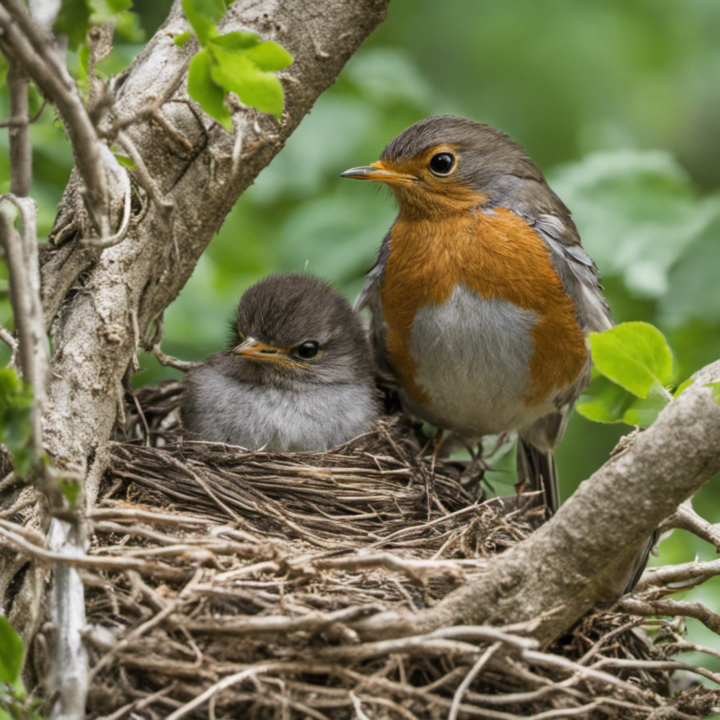
Baby Robins
Baby robin birds, also known as nestlings, are born featherless and helpless.
They rely entirely on their parents for food and protection. During the first few days, the mother spends most of her time incubating the eggs and keeping the nestlings warm, while the father brings food to the nest.
As the nestlings grow, both parents work tirelessly to feed them a diet rich in insects and worms.
The parents’ beaks are specially adapted for grasping and delivering food to their hungry chicks.
After about two weeks, the young robins fledge and leave the nest, though the parents continue to care for them until they become independent. In Conclusion
So there you have it – all about the robin bird!
These charismatic robin birds with their striking appearance, beautiful songs, and fascinating behaviors bring joy to people across North America.
From their nesting habits to their migratory patterns, the robin’s life is full of wonder and amazement.
The next time you hear a robin’s cheerful song, take a moment to appreciate the wonders of nature that surround us all.
We hope you liked our article :- All About The Robin.
Frequently Asked Questions: All About The Robin
1. What is an American Robin?
An American Robin, scientific name Turdus migratorius, is a medium-sized migratory songbird found in North America.
It is known for its distinctive reddish-orange breast, grayish-brown back, and white belly. The American Robin is the state bird of Connecticut, Michigan, and Wisconsin.
2. What do Robin birds eat?
Robin birds have a diverse diet that mainly consists of:
- Insects
- Earthworms
- Berries
- Fruits
- Occasional small reptiles
3. How do Robins build their nests?
Robins construct cup-shaped nests made of:
- Twigs
- Grass
- Mud
These nests are typically lined with soft materials such as moss and feathers. The nest is usually built in the forks of trees or on ledges like window sills. The female robin bird takes the lead in nest-building.
4. Where do Robins migrate to?
Robins are migratory birds, and they undertake extensive journeys during the winter months. They migrate from the northern regions of North America to:
- The southern United States
- Mexico
- Central America
Some robins stay in their breeding territory throughout the year, particularly in milder climates.
5. What is the habitat of Robins?
Robins are adaptable birds that can be found in various habitats, including:
- Forests
- Woodlands
- Parks
- Gardens
- Suburban areas
They prefer areas with open spaces and plenty of trees or shrubs where they can build their nests and find food easily.
6. How do Robins behave?
Robins are known for their territorial behavior. They aggressively defend their nesting territories, especially during the breeding season. They are also known for running or hopping on the ground when searching for food. Robin birds are generally calm and social birds that often gather in flocks during non-breeding seasons.
7. What are some popular Robin songs?
Some popular Robin songs include:
| Song | Audio |
|---|---|
| Cheer-up, cheerily, cheer-up, cheerily | N/a |
| Cher-o-lee, cher-o-lee, cher-o-lee | N/a |
| Sweet, sweet, sweet, I’m so sweet | N/a |
8. How do baby robins develop?
Baby robins, or nestlings, hatch from eggs after an incubation period of around 12-14 days.
They are initially naked and helpless but rapidly grow feathers within a week.
The parents feed the nestlings a diet of insects until they are ready to fledge, which usually occurs around 14-16 days after hatching.
